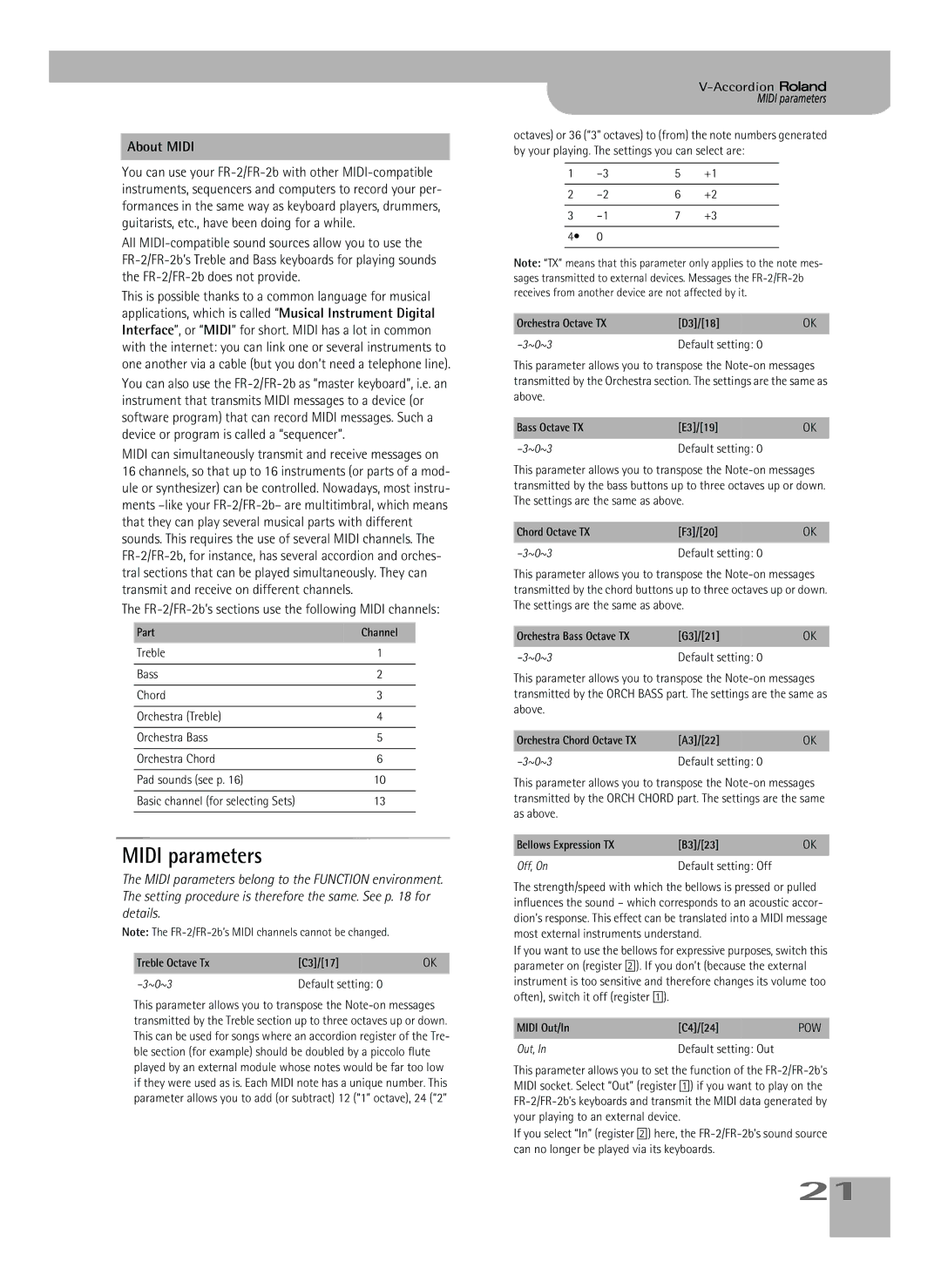
About MIDI
You can use your
All
This is possible thanks to a common language for musical applications, which is called “Musical Instrument Digital Interface”, or “MIDI” for short. MIDI has a lot in common with the internet: you can link one or several instruments to one another via a cable (but you don’t need a telephone line).
You can also use the
MIDI can simultaneously transmit and receive messages on 16 channels, so that up to 16 instruments (or parts of a mod- ule or synthesizer) can be controlled. Nowadays, most instru- ments
The FR-2/FR-2b’s sections use the following MIDI channels:
Part | Channel |
Treble | 1 |
|
|
Bass | 2 |
|
|
Chord | 3 |
|
|
Orchestra (Treble) | 4 |
|
|
Orchestra Bass | 5 |
|
|
Orchestra Chord | 6 |
|
|
Pad sounds (see p. 16) | 10 |
|
|
Basic channel (for selecting Sets) | 13 |
|
|
MIDI parameters
The MIDI parameters belong to the FUNCTION environment. The setting procedure is therefore the same. See p. 18 for details.
Note: The
Treble Octave Tx | [C3]/[17] | OK |
| Default setting: 0 |
|
This parameter allows you to transpose the
MIDI parameters
octaves) or 36 (“3” octaves) to (from) the note numbers generated by your playing. The settings you can select are:
1 | 5 | +1 | |
2 | 6 | +2 | |
|
|
|
|
3 | 7 | +3 | |
|
|
|
|
4• | 0 |
|
|
|
|
|
|
Note: “TX” means that this parameter only applies to the note mes- sages transmitted to external devices. Messages the
Orchestra Octave TX | [D3]/[18] | OK |
Default setting: 0 |
|
This parameter allows you to transpose the
Bass Octave TX | [E3]/[19] | OK |
Default setting: 0 |
|
This parameter allows you to transpose the
Chord Octave TX | [F3]/[20] | OK |
Default setting: 0 |
|
This parameter allows you to transpose the
Orchestra Bass Octave TX | [G3]/[21] | OK |
Default setting: 0 |
|
This parameter allows you to transpose the
Orchestra Chord Octave TX | [A3]/[22] | OK |
Default setting: 0 |
|
This parameter allows you to transpose the
Bellows Expression TX | [B3]/[23] | OK |
Off, On | Default setting: Off |
|
The strength/speed with which the bellows is pressed or pulled influences the sound – which corresponds to an acoustic accor- dion’s response. This effect can be translated into a MIDI message most external instruments understand.
If you want to use the bellows for expressive purposes, switch this parameter on (register [2]). If you don’t (because the external instrument is too sensitive and therefore changes its volume too often), switch it off (register [1]).
MIDI Out/In | [C4]/[24] | POW |
Out, In | Default setting: Out |
|
This parameter allows you to set the function of the
If you select “In” (register [2]) here, the
21
